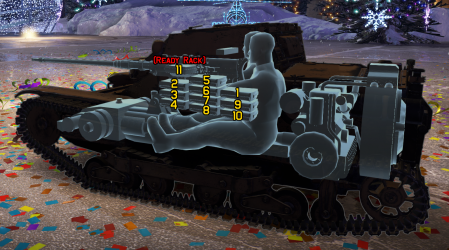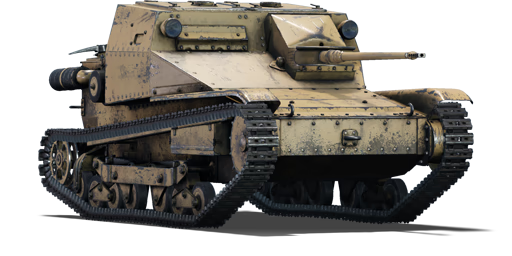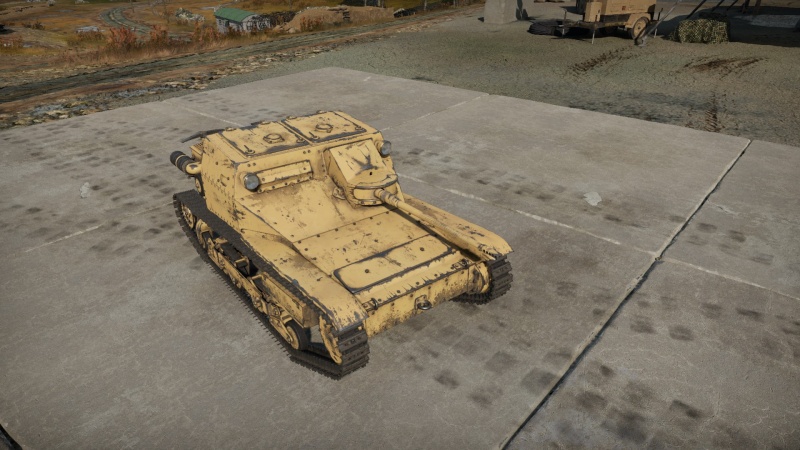Difference between revisions of "L3/33 CC"
U107627675 (talk | contribs) (→History: variants, radio center and bridgelayer) |
(Edits) |
||
| Line 150: | Line 150: | ||
== History == | == History == | ||
<!-- ''Describe the history of the creation and combat usage of the vehicle in more detail than in the introduction. If the historical reference turns out to be too long, take it to a separate article, taking a link to the article about the vehicle and adding a block "/History" (example: <nowiki>https://wiki.warthunder.com/(Vehicle-name)/History</nowiki>) and add a link to it here using the <code>main</code> template. Be sure to reference text and sources by using <code><nowiki><ref></ref></nowiki></code>, as well as adding them at the end of the article with <code><nowiki><references /></nowiki></code>. This section may also include the vehicle's dev blog entry (if applicable) and the in-game encyclopedia description (under <code><nowiki>=== In-game description ===</nowiki></code>, also if applicable).'' --> | <!-- ''Describe the history of the creation and combat usage of the vehicle in more detail than in the introduction. If the historical reference turns out to be too long, take it to a separate article, taking a link to the article about the vehicle and adding a block "/History" (example: <nowiki>https://wiki.warthunder.com/(Vehicle-name)/History</nowiki>) and add a link to it here using the <code>main</code> template. Be sure to reference text and sources by using <code><nowiki><ref></ref></nowiki></code>, as well as adding them at the end of the article with <code><nowiki><references /></nowiki></code>. This section may also include the vehicle's dev blog entry (if applicable) and the in-game encyclopedia description (under <code><nowiki>=== In-game description ===</nowiki></code>, also if applicable).'' --> | ||
| − | The '''Carro Veloce L3/33''', also known as the '''CV-33''' was a | + | The '''Carro Veloce L3/33''', also known as the '''CV-33''' was a tankette produced by Ansaldo for the Regio Esercito beginning in 1933. The design was an adaptation of the British Carden Loyd tankette, which had seen wide success on the international export market and became the basis for a number of similar tankette designs throughout the 1930s. Because Italy lacked the industrial base to produce large numbers of more complex and advanced tank designs, the L3/33 and later L3/35 tankette formed the backbone of the Italian armoured corps and became the most widely produced Italian armoured fighting vehicles of the war, seeing service from the Italian invasion of Ethiopia to the very end of WW2. Several variants were produced, including a flamethrower variant (the L3/33 LF, standing for "LanciaFiamme"), a bridge carrier variant (L3/33 Passerella, with a 7 m bridge transported on a trailer that could be assembled by the crew in seven minutes and placed with two small cranes fastened on the chassis) and a command radio variant (L3 Centro Radio, equipped with a Marelli RF1 CA radio at level of platoons and companies). For the use of a radio station powerful enough to serve a regimental radio center, the L3 chassis was considered not suitable and replaced with a more spacious [[L6/40]] CR (Centro Radio = Radio Center). |
| − | As the war progressed, and the Italians faced the Allies in France and North Africa with their more heavily armed and armoured tanks and long-range anti-tank guns, the deficiencies of the L3/33 and 35 became apparent. Although fast and possessing a low profile, it was too thinly armoured, capable of only withstanding infantry rifle calibre munitions. In addition, its standard armament of a 6.5mm machine gun proved inadequate for long-range combat or engaging other armoured vehicles. While the Regio Esercito began slowly upgrading its armoured units to more modern standards, stopgap solutions to make up for the difference were considered and adopted. One of these was to mount a | + | As the war progressed, and the Italians faced the Allies in France and North Africa with their more heavily armed and armoured tanks and long-range anti-tank guns, the deficiencies of the L3/33 and 35 became apparent. Although fast and possessing a low profile, it was too thinly armoured, capable of only withstanding infantry rifle calibre munitions. In addition, its standard armament of a 6.5mm machine gun proved inadequate for long-range combat or engaging other armoured vehicles. While the Regio Esercito began slowly upgrading its armoured units to more modern standards, stopgap solutions to make up for the difference were considered and adopted. One of these was to mount a 20 mm Fucile Controcarri S Mod.39 anti-tank gun in a small number of L3/33s and 35s, replacing the 6.5 mm machine gun and creating an ad hoc tank destroyer platform. These were designated as the '''L3/33 CC''', which stood for "controcarro" ("anti-tank"). Arriving too late to see action in Libya before the Axis retreat, they saw only limited action in Tunisia. Gradually, the L3/33 and L3/35 would be withdrawn from front line service, serving largely in behind-the-line roles such as artillery towing vehicles and police vehicles in Axis-occupied territories. After the Axis fell, many tanks were captured and either destroyed or repurposed. The last recorded use of an L3/33 in service was during the Iraqi war, where the US captured the tank. |
== Media == | == Media == | ||
Revision as of 18:33, 5 September 2021
Contents
Description
The Carro Armato L3 Contro Carro (shortened to L3/33 CC) is a rank Italian tank destroyer with a battle rating of (AB), (RB), and (SB). It was introduced in Update 1.85 "Supersonic".
The L3/33 CC is an Italian tankette that is the War Thunder equivalent of a shoe-box on tracks (with a gun, of course). This vehicle has very little armour, which allows for it to quickly and deftly manoeuvre across the battlefield, scouting for pockets to position the vehicle in for tactical advantages against the slower and heavier enemy vehicles it faces.
General info
Survivability and armour
| Armour | Front (Slope angle) | Sides | Rear | Roof |
|---|---|---|---|---|
| Hull | 8 mm (79°) Front glacis 14 mm (0°) Lower glacis |
14 mm | 8 mm (0-32°) | 8 mm 5 mm Hatches |
| Superstructure | 14 mm (13-64°) 14 mm (0-62°) Gun mantlet |
14 mm (0-15°) | 14 mm (0-17°) | 8 mm 5 mm Hatches |
Mobility
| Game Mode | Max Speed (km/h) | Weight (tons) | Engine power (horsepower) | Power-to-weight ratio (hp/ton) | |||
|---|---|---|---|---|---|---|---|
| Forward | Reverse | Stock | Upgraded | Stock | Upgraded | ||
| Arcade | Expression error: Unexpected * operator. | 61 | Expression error: Unexpected round operator. | __.__ | |||
| Realistic | 38 | Expression error: Unexpected round operator. | __.__ | ||||
The L3/33 CC is very mobile both on and off-road. Thanks to its light weight, it accelerates quickly and can cruise at 40 / 25 km/h (AB/RB) in seconds. It does not lose much speed when turning but tends to oversteer when turning while driving over 40 km/h (in AB). With only -6 km/h in reverse (AB & RB), turning around and driving away is easier to retreat form unwanted situations.
Modifications and economy
Armaments
Main armament
Wielding an anti-tank rifle with a 10 round magazine capable of launching a small APHE every second, the L3/33, in the hands of a competent commander, is able to deal with multiple lightly-armoured vehicles in quick succession. The only thing holding this quick-firing gun back is a lack of effective penetration to deal with all tanks at its battle rating, requiring the commander of this vehicle to be up close and personal and/or flank in order to deal with well-armoured targets (M3 Stuart, Pz.38(t) F, T-70). Certain heavy targets (B1 bis) should be avoided altogether.
| 20 mm Fucile Controcarri S Mod.39 | Turret rotation speed (°/s) | Reloading rate (seconds) | ||||||||||||
|---|---|---|---|---|---|---|---|---|---|---|---|---|---|---|
| Mode | Capacity (Belt) | Fire rate | Vertical | Horizontal | Stabilizer | Stock | Upgraded | Full | Expert | Aced | Stock | Full | Expert | Aced |
| Arcade | 110 (10) | 60 | ±15° | ±10° | Vertical | 17.6 | 24.4 | 29.6 | 32.7 | 34.8 | 7.80 | 6.90 | 6.36 | 6.00 |
| Realistic | 11.9 | 14.0 | 17.0 | 18.8 | 20.0 | |||||||||
Ammunition
| Penetration statistics | |||||||
|---|---|---|---|---|---|---|---|
| Ammunition | Type of warhead |
Penetration @ 0° Angle of Attack (mm) | |||||
| 10 m | 100 m | 500 m | 1,000 m | 1,500 m | 2,000 m | ||
| Perforante mod.35 | APHE | 40 | 38 | 29 | 20 | 14 | 10 |
| Shell details | |||||||||
|---|---|---|---|---|---|---|---|---|---|
| Ammunition | Type of warhead |
Velocity (m/s) |
Projectile Mass (kg) |
Fuse delay (m) |
Fuse sensitivity (mm) |
Explosive Mass (TNT equivalent) (g) |
Ricochet | ||
| 0% | 50% | 100% | |||||||
| Perforante mod.35 | APHE | 832 | 0.14 | 1.2 | 9 | 1.7 | 47° | 60° | 65° |
Ammo racks
| Full ammo |
1st rack empty |
2nd rack empty |
3rd rack empty |
4th rack empty |
5th rack empty |
6th rack empty |
7th rack empty |
8th rack empty |
9th rack empty |
10th rack empty |
11th rack empty |
Visual discrepancy |
|---|---|---|---|---|---|---|---|---|---|---|---|---|
| 11 | 10 (+1) | 9 (+2) | 8 (+3) | 7 (+4) | 6 (+5) | 5 (+6) | 4 (+7) | 3 (+8) | 2 (+9) | 1 (+10) | 0 (+11) | No |

Usage in battles
The L3/33 CC is best used in ambushes, as this tactic allows it to strike from a close distance; a hill can provide a nice spot for this, as the L3 has 15 degrees of gun depression and can get to cover by simply reversing if it is spotted in time. It is also useful as a flanker due to its small size (hard to spot) and high mobility.
When playing the L3/33, incoming fire should be avoided at all costs. Due to the cramped layout of internal modules and crew of 2, any penetrating shell is enough to destroy the vehicle. In addition, the armour is so weak that it cannot even protect against .50 calibre machine gun: play carefully.
Enemies worth noting:
B1:
The B1 is covered by thick armour of at least 50 mm in all directions, even the turret ring and the cupola are 40 mm which all exceed the maximum penetration of the L3 (38 mm). Do anything to avoid fighting this tank, leave it to your teammates by pinning its position on the map. But if unfortunately, you have to confront it, you must avoid its guns. Don't think you are small enough to slide beneath its guns, as it's hull-mounted 75 mm cannon has a whopping -20° depression, and the 47 mm in the turret has -18°, meaning that even if you are squeezing right between its tracks, it can still hit your fragile roof armour and eliminate a crew member with shrapnel. The only real damage you can do to it is to repeatedly shoot at its tracks to immobilize it.
Pros and cons
Pros:
- Extremely tiny profile is sometimes a big advantage
- It utilizes small amounts of cover/bushes effectively
- Can easily sneak into lots of unexpected positions and set up for an ambush, advance or retreat
- Low silhouette can be fully covered behind a single one big bush decoration. It can even be covered with normal grass
- Amazing gun depression of -15° makes it a great mountain combat tank; combined with its tiny profile it can poke out only its gun to shoot from behind cover
- Quick firing cannon with an autoloading magazine can pinpoint enemy crew, especially with the spread-out ones like the LVT(A)
- Short stock grind, the best (and only) shell comes stock
Cons:
- The 20 mm rounds' penetration isn't great and drops dramatically over range: over 400 m away it can effectively penetrate nothing except soft targets like T-26, GAZ trucks or Flakpanzers.
- Thin armour with only two crew cramped together makes it very vulnerable
- Vulnerable to .50 calibre fire, one bullet to the crew can eliminate the tank
- Low cannon calibre of 20 mm makes it difficult to destroy obstacles like walls
- 3rd person camera is low to the ground, preventing the player from looking behind obstacles such as low fences
- The vehicle has such small mass that even trivial obstacles like fences can cause significant deceleration
History
The Carro Veloce L3/33, also known as the CV-33 was a tankette produced by Ansaldo for the Regio Esercito beginning in 1933. The design was an adaptation of the British Carden Loyd tankette, which had seen wide success on the international export market and became the basis for a number of similar tankette designs throughout the 1930s. Because Italy lacked the industrial base to produce large numbers of more complex and advanced tank designs, the L3/33 and later L3/35 tankette formed the backbone of the Italian armoured corps and became the most widely produced Italian armoured fighting vehicles of the war, seeing service from the Italian invasion of Ethiopia to the very end of WW2. Several variants were produced, including a flamethrower variant (the L3/33 LF, standing for "LanciaFiamme"), a bridge carrier variant (L3/33 Passerella, with a 7 m bridge transported on a trailer that could be assembled by the crew in seven minutes and placed with two small cranes fastened on the chassis) and a command radio variant (L3 Centro Radio, equipped with a Marelli RF1 CA radio at level of platoons and companies). For the use of a radio station powerful enough to serve a regimental radio center, the L3 chassis was considered not suitable and replaced with a more spacious L6/40 CR (Centro Radio = Radio Center).
As the war progressed, and the Italians faced the Allies in France and North Africa with their more heavily armed and armoured tanks and long-range anti-tank guns, the deficiencies of the L3/33 and 35 became apparent. Although fast and possessing a low profile, it was too thinly armoured, capable of only withstanding infantry rifle calibre munitions. In addition, its standard armament of a 6.5mm machine gun proved inadequate for long-range combat or engaging other armoured vehicles. While the Regio Esercito began slowly upgrading its armoured units to more modern standards, stopgap solutions to make up for the difference were considered and adopted. One of these was to mount a 20 mm Fucile Controcarri S Mod.39 anti-tank gun in a small number of L3/33s and 35s, replacing the 6.5 mm machine gun and creating an ad hoc tank destroyer platform. These were designated as the L3/33 CC, which stood for "controcarro" ("anti-tank"). Arriving too late to see action in Libya before the Axis retreat, they saw only limited action in Tunisia. Gradually, the L3/33 and L3/35 would be withdrawn from front line service, serving largely in behind-the-line roles such as artillery towing vehicles and police vehicles in Axis-occupied territories. After the Axis fell, many tanks were captured and either destroyed or repurposed. The last recorded use of an L3/33 in service was during the Iraqi war, where the US captured the tank.
Media
- Skins
- Videos
See also
- Vehicles of comparable role, configuration and era
External links
| Italy tank destroyers | |
|---|---|
| Italy | |
| M41 | 75/18 M41 · 75/32 M41 · 90/53 M41M |
| M42 | 75/34 M42 |
| M43 | 105/25 M43 · M43 "G.C.Leoncello" · 75/34 M43 · 75/46 M43 |
| Wheeled | Lancia 3Ro (100/17) · AS 42/47 · Breda 90/53 · Breda 501 |
| Other | L3/33 CC · 47/32 L40 |
| Germany | ▄StuG III G |
| USA | M36B1 · ▄M109G · M113A1 (TOW) |
| Hungary | |
| Zrínyi | Zrinyi I · Zrinyi II |
| USSR | ◔2S1 |





